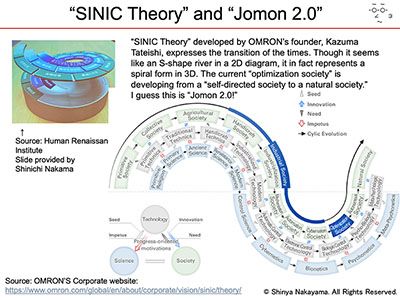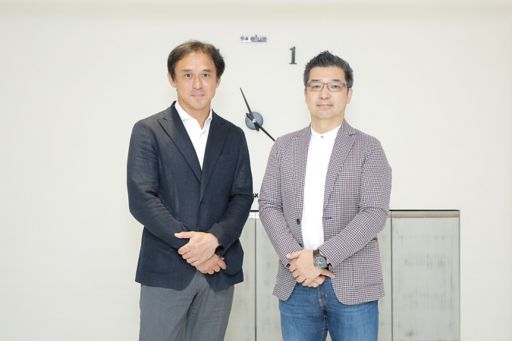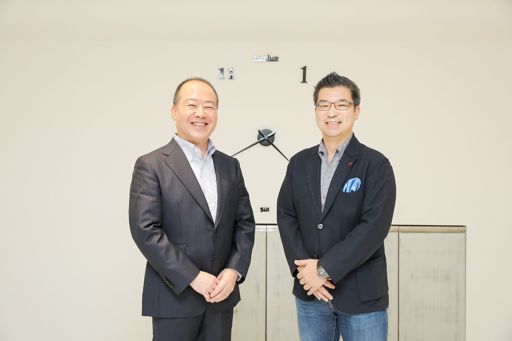Since the spread of COVID-19, major companies in particular have started to focus their attention on “philosophy-based management.” Also, an increasing number of people are becoming resolved to start small businesses in this age of growing uncertainty. Meanwhile, as you already know, digitalization and technology have been rapidly permeating our lives in recent years. These two events are not occurring in different world lines but are connected without doubt. So, what kind of society lies in store in the future?
In this article, we will introduce the discussions conducted between Shinya Nakayama, Principal, Rakuten University, Rakuten Group, Inc., and Masayuki Chatani from KPMG Ignition Tokyo. They take a quick overview of how technology and the awareness to accept technology are revolutionizing how we live and work, how we find value and how an organization should be while also envisioning and fantasizing what kind of society awaits us in the post-COVID-19 age.
Contents
- Link to Vol. 1
- DX Is Like “Sticking a Toothpick into an Egg Yolk” - Example of Transformation of an SME -
- Implementation of “Flow Theory” Eliminates the Need for Marketing
- “Organization Cat” for People Who Are Uncomfortable with “Organization Dog”
- Creation of Value Beyond the Framework of the Company - Not Working but “Playing Together” -
- How Can We Acquire “Skills to Be Able to Play?”
- Post-COVID-19 is the Age of “Jomon 2.0!”
- Profile of Interviewee
DX Is Like “Sticking a Toothpick into an Egg Yolk” - Example of Transformation of an SME -

(Shinya Nakayama, Principal of Rakuten University, Rakuten Group, Inc. and CEO of Nakayama Kozai Co., Ltd. (left), Masayuki Chatani, Representative Director & CEO of KPMG Ignition Tokyo and CDO of KPMG Japan (right)) *Professional affiliation and official position in the article are at the time of publication.
Chatani: Listening to your stories, I felt that the “official name of DX is not Digital Transformation” in terms of SMEs (Small and medium-sized enterprises) . I would like to explore this a little more deeply.
Nakayama: Digital technology is a means. Value is something people feel and whether it is an EC site or a real store, the fact that customers are analogue human beings does not change.
Therefore, it’s only the tool that is digital and what we need to transform is the analogue value. In other words, I think that the essence of DX is to “transform the analogue value with digital technology” and this is what DX is especially for SMEs.
After all, as customers cannot feel it unless it is output as an analogue value such as “I started enjoying my life” or “my life became convenient,” I think that this will not change even if the tool changes.
Chatani: You wrote before that “DX is like sticking a toothpick into an egg yolk,” but what did you mean by that?
Nakayama: One day, a merchant selling eggs at Rakuten was watching TV and saw people being surprised at the topic that “a toothpick can be stuck into an egg yolk because the egg is fresh.” The egg merchant had never even thought about talking about this because it was so normal for them. However, as they had long been aware of the issue that while their eggs were distributed in Kyushu, most of the people in the country had not tasted them, they were wondering how they could convey the quality of their eggs to people who had never tasted them. This then led them to come up with an idea for a project.
The project was to create a webpage for the product with a password and advertise it as follows: “As the topic of sticking a toothpick into an egg yolk has become popular, we tried it with our egg. How many toothpicks do you think we were able to stick into the yolk? The correct answer is the password. Those of you who are able to enter the page can apply for our give-away campaign.”
This campaign drew a lot of attention and I heard that there were many excited messages such as “this campaign is really fun” and “the whole family was excited” in the free comment field of the give-away application form.
The significance of this project was that it was not only interesting but was able to deliver the intrinsic value of “conveying the high quality of the eggs.” I think that this kind of creativity and mobility leads to the DX of SMEs. This story, in fact, took place more than 20 years ago (laughs).
Chatani: I guess this means that we need to redefine the value of what we provide based on the premise of the digital world.
Nakayama: That’s right. What is important is the viewpoint of how we can make use of the strength of digital technology, such as “even a niche business is viable with the expansion of trading areas” and “the possibility of delivering value expands because the cost of communicating with customers can be reduced dramatically.”
Implementation of “Flow Theory” Eliminates the Need for Marketing
Chatani: On the other hand, even if trading areas are expanded, some kind of marketing activities are necessary to get people to know that “there is a store here,” which I think is a very difficult thing to do. What is the solution to this?
Nakayama: I think that this indeed leads to the “flow theory” I mentioned earlier. SMEs that have succeeded in DX such as the “Fighting Eyeglass Store” are operating with excitement every day, not knowing whether they are working or playing. If they continue to send out what they enjoy, a positive spiral of people around them becoming happier and the network expanding further goes on and on.
In fact, I think that if we continue to “have fun” with customers in a state of flow after properly designing our value, the concept of “attracting customers” will no longer be necessary. I think that in this age when social media has penetrated society, information can spread online through word-of-mouth and a community surrounding one’s business can also be created. I feel that SMEs that are successful in DX and IT have this kind of mindset and are operating based on this mindset.
Flow Theory
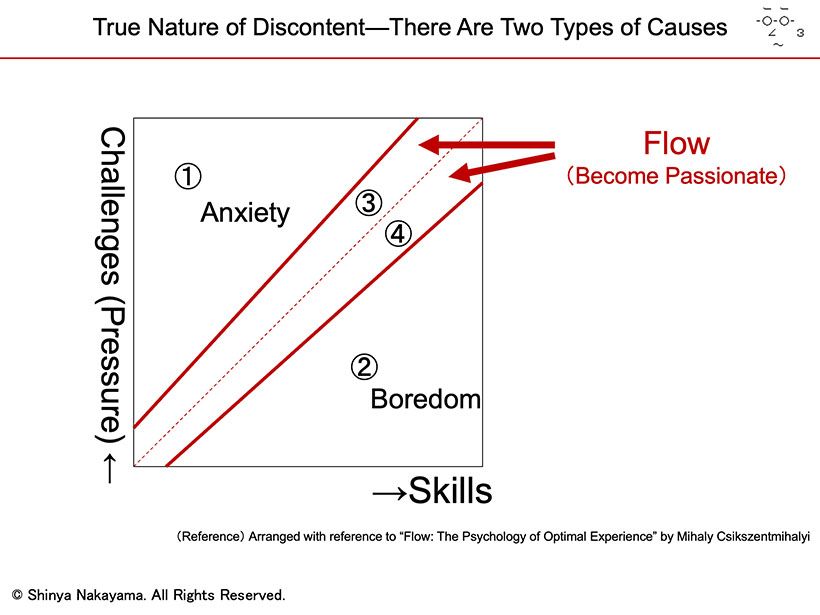

Chatani: Without doubt, communication in play and hobby-related networks is very fast. I often wonder why it takes so long to adjust the date of a meeting when we can set the date of a drinking party or a golf competition so fast. I guess there is a difference in the amount of energy we put into it (laughs).
Nakayama: You’re quite right (laughs).
Going back to what we were talking about, I myself have also been focusing on expanding the network of community rather than on the concept of attracting customers. I believe that what I have been doing at Rakuten is to create lateral connections while “playing” with the merchants, which resulted in the creation of merchants’ communities.
This is not recognized much but Rakuten Ichiba has been an SaaS business for 20 years. The value of an SaaS business depends on how skillfully customers utilize the service. What is important is that the more skillfully merchants use the Rakuten System, the more their sales improve and become profitable. This is why actions to increase the number of merchants who can skillfully utilize the system becomes extremely important for platformers.
As successful education and training are plowed back into their own business in this model, Rakuten will run short of resources if we can only create a 1 vs. N relationship with our merchants.
Therefore, we cultivate lateral connections that can realize an N vs. N relationship and create a community where the merchants can ask and teach each other things. For example, they say, “How are you using this function?” or “If you’re concerned with such a problem, you should use this service.” They also stimulate each other by saying, “Our monthly sales exceeded 10 million yen!” and “Congratulations! We will work hard too.” As a result, the number of happy “self-directed” merchants increases.
Chatani: I suppose it means that the business can grow because there is a community.
Nakayama: That’s right. In recent years, we have been receiving more inquiries from people who are operating a platform-type SaaS business model that they want to know about Rakuten University.
After I ask them about their problems, my reply to most of them is: “Yes, there has been that kind of problem at Rakuten as well, but we resolved it by enriching the community.”
What I have been doing is simple. By creating lateral connections and making it a place where everyone can learn from each other, sales increase spontaneously while the merchants start engaging proactively in new functions and enjoying their work. They “thank us for being able to open a store at Rakuten” and there will be fewer merchants that close their stores. Word-of-mouth communication can lead to new business, with people saying, “I would like to introduce my friend who wants to open a store at Rakuten,” and we will also be able to enjoy our work when we hear such comments. This is how a positive circle is created. I feel that only good things can be generated by properly fostering a customer community.
As they continue to learn from each other in this way, for example, stores that have been in the business of purchasing and selling goods will develop a fan base, and when the number of customers who support them exceeds a certain number, they will be able to overcome the “lot barrier” of private brand products and become manufacturers. By implementing the so-called D2C model, merchants can increase their profit margins and express their world view better.
Knowhow about going up the stages can also be learned from forerunners if they have a good community. This is why only good things can be generated when the community is enriched.
Chatani: Such a community is probably not viable unless it consists of a group of self-directed people.
Nakayama: Yes, because there is no one who is going to give them instructions.
“Organization Cat” for People Who Are Uncomfortable with “Organization Dog”
Four Types of Organization Animals
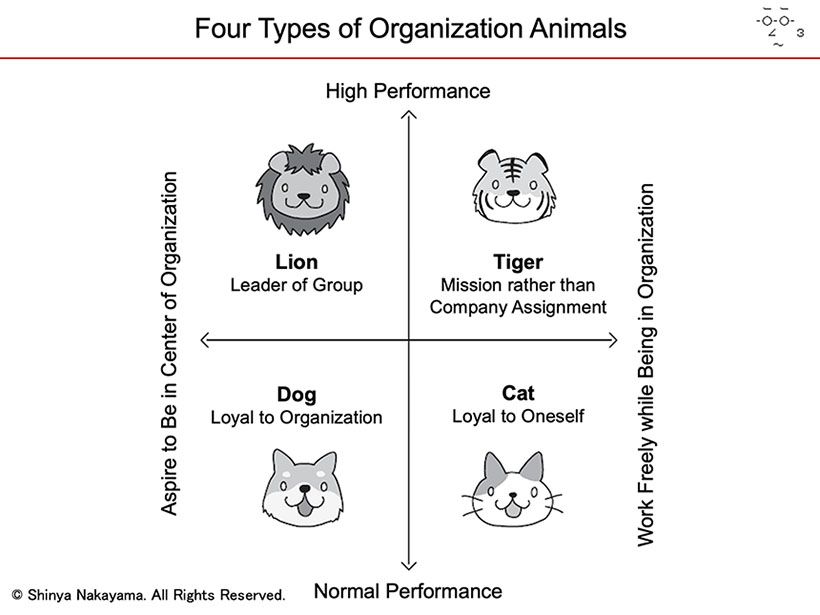
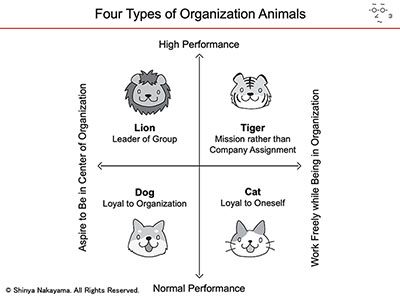
Chatani: Now, let’s talk about your latest book, “Working Style of ‘Organization Cat: Hints for Continuing to Produce Results for People Who Are Uncomfortable with ‘Organization Dog’ (Published by Shoeisha),” which was published on November 10, 2021. “Organization cat for people who are uncomfortable with organization dog” seems like a very catchy phrase. Can you tell us a little bit about the book?
Nakayama: I think “organization dog” is an idiomatic expression but I feel that there are many people who think that “to work is to act as an organization dog.”
The other day, I was invited to a class where we talked about working styles with university students. When I asked the students “what do you think it means to work?,” there were many students who replied, “to earn money to eat” and “to become an organization dog.”
The “organization dog” working style is similar to the baseball-type OS, which is a sense of value in being loyal to the organization by “properly doing what is instructed.”
Dog-type people can work in a healthy manner when the company is growing smoothly. However, behind the corporate frauds that have been frequently occurring in recent years, there are many cases where “the fraud was committed by following the orders of a superior.” There have also been business people who had committed fraud by being “loyal” to these orders while carrying great psychological burdens and ending their life in the worst case.
These frauds occur because the expiration date of the business or organization has probably been reached.
I imagine that large companies that grew through the high economic growth period were working with passion as a “flow organization” with everyone working vigorously and talking ‘yackety-yak’ when they started the business.
However, after the scale of their business grew and it went through the division of labor, their business and organization became out-of-date due to a change in the environment. Even though various things started to go wrong, they continued to refuse to change and ended up giving instructions to commit fraud in order to cover the loopholes. This is my viewpoint.
When a company is growing in an industrial society, it is easier to enhance efficiency if all employees work as “organization dogs.” The harder they work, the more the performance of the company grows and the more they feel that “work is hard but rewarding!” However, this type of working style reaches a dead end when it enters the age when there is no correct answer.
The book suggests that there must be people who will be rescued if they know that there is an option to work as an “organization cat.”
“Organization cats” do not prioritize the organization but can say “no” based on their own code of value when they are instructed to do something against their policy, such as being ordered to commit fraud.
For instance, when they are told to increase sales even if they have to disregard customers, “organization cats” are those who think “I don’t want to do that!” and manage to avoid having to do it or neglect the instruction as if they were not listening.
In order for them to stand firm on this style, they need to implement a working style of properly providing customers with value, thoroughly doing what makes customers happy and creating an environment surrounded by customers who support them before they face such a situation.
I think that there are many people who are originally cats but “put on a dog’s skin,” believing that “to work is to become an organization dog.” These people must feel tired when the company they belong to becomes out-of-date, working as the “organization dog” doesn’t go well, and they are unable to “find meaning in working as a dog.”
Also, as “organization cats” want customers to be happy, they are open to starting something new. As there is now a public trend of valuing new business development, I think it’s important to prepare an environment where “organization cats” can work actively.
Chatani: That’s true. When launching a new business or an unprecedented product, bee-like people who can work as a pollinizer who flies between multiple divisions to develop potential is necessary, and I think that my “misfit employee” senior associates who helped me in various ways when I was working at Sony had assumed this role.
It is extremely important to be able to find people who value this type of essence and can say coolly, “don’t you think it would be interesting to connect this and this?” We talked about “organization dogs” and “organization cats” but aren’t there “organization lions” and “organization tigers” as well?
Nakayama: When the cat goes to the next level, it becomes a tiger. Tigers are admired by cats as a presence that creates new value. Lions are conventional “great leader” types who lead people in the center of the organization.
Chatani: Does this mean that it is ideal for great leaders to change into tigers going forward?
Nakayama: Tiger-type people are change agents. This indeed overlaps with the phrase “it is the misfit employees who realize transformation” in the book “Start Looking for Personnel Beginning with ‘Misfit Employees’: Secret of ‘Passionate Group’ that Creates Miracles (Published by Kodansha)” mentioned in the first part of this discussion.
The dogs would often say about tigers, “What’s wrong with those people?!!” or “We’re doing exactly as we’re told but they’re not following any of the rules!”
They may also be considered troublemakers, with people saying, “That person seems to be doing something somewhere without coming to the company at all. Who do you think he is and why is he allowed to do that!?”
However they are considered, tigers act based on their feeling that “it might be interesting to connect this and this” and create something new in collaboration with someone they become friendly with in the course of talking with that person. It will be good for future management teams to create an environment where it is easy for these kinds of people to move around.
Chatani: You’re quite right. I think that new businesses and innovations are created in such ways.
Creation of Value Beyond the Framework of the Company - Not Working but “Playing Together” -
Chatani: While “promote DX” has recently become an intra-company slogan, it used to be “do something with AI” that was being commanded when AI was beginning to draw attention. However, if a company tries to do that, I suppose they need to go into a “self-searching journey of the company” even if it is a socially recognized company. This is because they cannot do anything unless they can find the value of the company’s existence, that is, “what purpose the company exists for in the first place.”
The importance of Purpose has often been talked about in the context of ESG management recently, but it is necessary to find it. Essentially, each and every employee and the people who support them need to be thinking about it on a regular basis.
Nakayama: Yes, I think that value creation that goes beyond the framework of a company and a co-creation relationship will be required even more going forward.
The process of creating value is to have “players = myself” and “playmates = customers, other companies including those in the same industry as well as other industries, freelancers, NPOs, and government organizations” who can enjoy “interesting games = projects” with the “same sense of value.” We call these Player, Partner, Project and Philosophy, the “4Ps of co-creation.”
Chatani: It’s important that more and more people are able to do this, but is the foundation of this based on experience? Does education make them acquire “something” that enables them to do this?
Nakayama: First of all, it’s important to increase opportunities to acknowledge that “there are people like that.” In terms of football, for example, the skills of children nowadays are incomparable to those of when we were children because they have more opportunities to see videos of top players playing football.
Just like football, what is important is whether there is an “environment that can be imitated.” Then, “the number of people who can do it” will increase on its own.
As people continue to imitate and taste a little success, the number of people who think “we can make a living by working in this style” will increase, which in turn will lead to a change in the working style.
Chatani: I see. This may be realized in 10 or 20 years from now, I guess.
Nakayama: Yes, I think it’s starting to occur already.
How Can We Acquire “Skills to Be Able to Play?”
Chatani: If we are to change to a co-creation working style with a sense of “let’s play together!,” it will also be necessary to acquire “skills to be able to play.” What do you think about this?
Nakayama: The “law of addition, subtraction, multiplication and division” is a concept that describes how we can acquire working skills and abilities. The beginning is the “addition” stage in which we increase what we can do by trying everything without being picky. As we increase the number of things we can do, we will be assigned more work and go into a state of overcapacity. As we contrive ways to do the surplus work and eventually manage to complete all the work, this means that “productivity has improved as a result of displaying our strength.” That’s probably when the question “what is our real strength?” emerges for the first time.
Four Stages of Working Style "Law of Addition, Subtraction, Multiplication and Division"
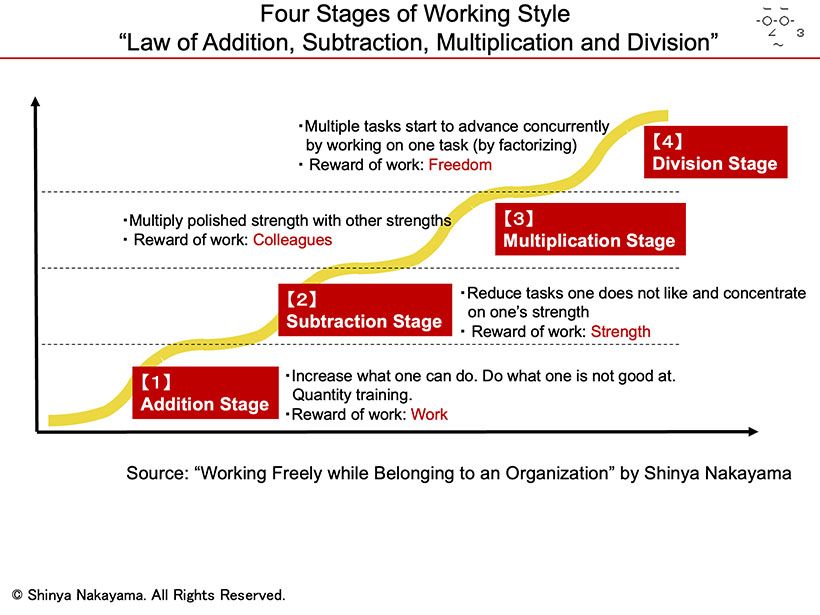

When we are able to understand what our strength is, we proceed to the next “subtraction” stage where we choose our work to polish our strength and let go of irrelevant work. If we can project our strength to a level where other people will agree that “you are good at this,” we will start to be asked, “I want you to make use of your strength in the project we are starting. Won’t you work with us?” This is the “multiplication” stage.
For a cat to become a tiger, it’s important to accomplish these “addition” and “subtraction” stages. It’s important to concentrate on what we must do now while sorting out “what stage I am now at and what is necessary for me now.”
Chatani: I can understand that well. If I can add something, it would be that it is possible to get in contact with diverse people at larger companies, as there are more samples of characters there.
In recent years, it has no longer been unusual to establish a startup while still at school but the members of the company tend to be of the same generation with similar backgrounds. I imagine in many cases, it’s difficult to realize diversity in terms of age, experience and career background internally even if there are various people outside the company.
Nakayama: In terms of internal diversity, the actual distribution of four quadrants, namely, “organization dogs, cats, lions and tigers” consists of a majority of dogs and a minority of cats. While cats and tigers are good at launching new businesses, they tend to lose interest when the business gets on the track. Dogs are good at operating a business, so if a company has a system where the cats can smoothly pass the baton to the dogs, it can be considered to be an organization with clear role assignments.
Tigers cannot survive in a dog-type company. If detailed plans and KPI reports are demanded too much when starting something new, tigers will feel very uncomfortable and leave the company.
On the other hand, companies where tigers can exist are very comfortable for cats as well. In an environment where tigers cannot survive, cats have no choice but to put on the skin of a dog.
Chatani: It must be difficult to protect the habitat of tigers in a dog-type company. Even if the top management is understanding to some extent, I imagine that it’s difficult to protect their habitat as there are various constraints.
Nakayama: That’s why I want to create a consensus in society that “tiger-like people and cat-like people are both necessary” by verbalizing the existence of tigers and cats.
Post-COVID-19 is the Age of “Jomon 2.0!”
Nakayama: As I think we are approaching the end of our dialogue, is it ok if I talk about a story that fantasizes the future? When I was thinking about creating organizations and teams, I found myself asking, “When did the working style of the division of labor start?” and arrived at the answer, “It started when we started growing rice in the Yayoi Period.”
Rice growing requires the cooperation of all the villagers. The person who is the most skilled at instructing people became the leader and allotted the roles of other villagers, indicating that these tasks would be necessary at this time of the year.
Before that time, during the Jomon Period, the production output of the village was maximized by each villager making use of what they were good at.
For example, if a person who is terrible at hunting boars but can find three times more shells than others is assigned to the “boar division,” the output of the village cannot be enhanced.
Spiral Development from Yayoi to Jomon 2.0?


That’s why they maximized the output by having all the villagers make use of what they were good at and exchanged surplus goods with the neighboring villages. In this way, people in the Jomon Period jointly managed the community smoothly.
In this respect, I imagine that after the “division of labor” style of working after the Yayoi Period runs into a wall, the spiral goes full circle and becomes “Jomon 2.0.”
Chatani: In a way, I guess it’s like connecting existing microservices possessing various unique functions. Now that communication and delivery costs for forming such groups have decreased, it’s probably not necessary to be big or gather and possess various functions under one umbrella.
Nakayama: You’re quite right. We can tell by looking at IT startups that they are existing as a startup because they do not need to be a large company. Or rather, if we consider the fact that they function better if they are not a large company, we arrive at the question, “why do we have to make the company big?” We need to seriously reconsider the supremacy of growth.
Chatani: I completely agree with you.
Nakayama: Regarding “Jomon 2.0,” the “SINIC Theory” provides a lot of suggestions. This is a business model where the spiral begins with the primitive society and goes around a full circle. We are now in an age when the industrialized and information-oriented society has ended and we are entering a society where the excesses are being optimized (an optimization society). The trend of SDGs indeed represents this optimization society.
If the industrialized society was the business style of the Showa Period, we can decipher that society is beginning to share the fact that this business style is out-of-date.
The “visualization of what is out-of-date” has been promoted especially due to the COVID-19 pandemic. With the spread of online communication and services, it has become easier to co-create value with geographically distant people and also easier to share value. This will be the trigger for the transition to the next “self-directed society,” which will lead to the “natural society” that lies ahead. I think this is the new community-type society, “Jomon 2.0.”
Chatani: I suppose that we are standing at the beginning of the next thousand years. Listening to your story about “Jomon 2.0” reminded me that companies and the people surrounding them are starting to lose the sense that “the real office is the center of work” and that everyone going online from their respective home to work together is becoming a common thing now. I felt that the mentality of people is beginning to get ready for the future working style you are fantasizing.
Profile of Interviewee

Shinya Nakayama
CEO, Nakayama Kozai Co., Ltd.
Principal, Rakuten University, Rakuten Group, Inc.
Shinya Nakayama joined Rakuten Group, Inc. during its inaugural period (with some 20 employees). In 2000, he established Rakuten University, a learning place for Rakuten Ichiba merchants, to foster a merchants’ community while conveying an essential and universal business framework focused on people.
In 2004, he established the “Vissel Kobe” official internet shop and doubled sales of goods in a style that promotes exchanges between the club and their fans.
In 2007, he became the only fellow-type official employee (official employees who can carry out concurrent business and attend the office freely) at Rakuten, and in 2008, he established his own company, Nakayama Kozai Co., Ltd., which creates materials for thinking and provides them with facilitation.
He signed a professional contract with the “Yokohama F. Marinos” from 2016 to 2017 and provided educational programs for coaches and junior players.
While watching and supporting tens of thousands of SMEs and venture companies for 20 years, he has been exploring management that does not fall into a war of attrition, co-creation marketing, creating an autonomous and self-directed organizational culture and teams that do not require instructions, building long-lasting communities, creating an environment where people can naturally grow, and working in a way that encourages people to play with their work while having a sense of passion.
His mission is to increase the number of “grown-ups who are passionate about their work and are admired by children.” His motto is “let’s play at work.”
He is the author of many books including “Working Style of ‘a Cat in an Organization’,” “Working Freely while Belonging to an Organization,” “Rules of Teams that Achieve Upset Victories with Existing Members” and “The Essence of Nurturing People.”
Follow us on KPMG Ignition Tokyo LinkedIn for the latest news.
Connect with us
- Find office locations kpmg.findOfficeLocations
- kpmg.emailUs
- Social media @ KPMG kpmg.socialMedia



